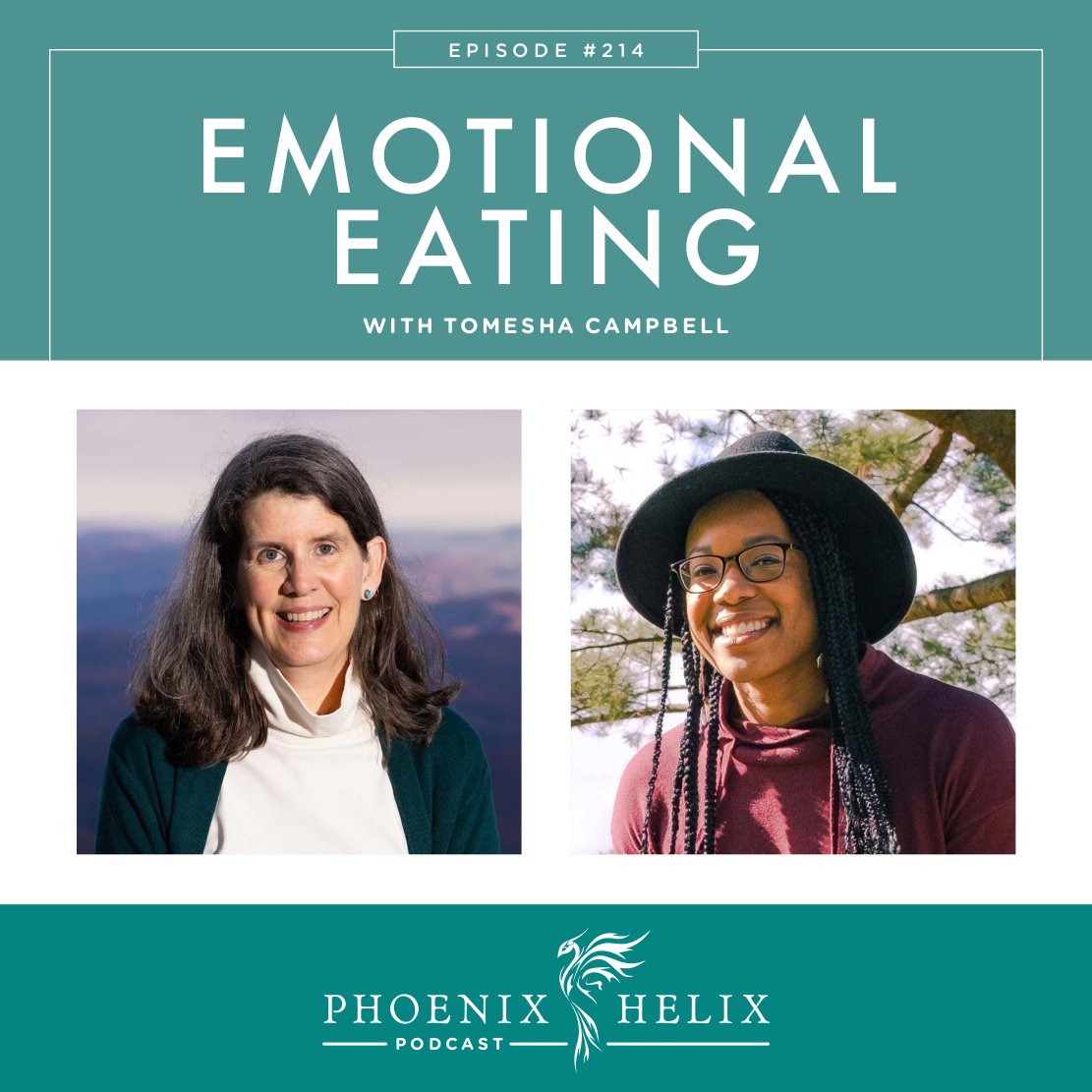What Happens When Comfort Food Hurts?
Food isn’t just about nutrition – it’s a mental and emotional experience as well. At its best, food fills us with joy and appreciation alongside the nutritional building blocks our bodies need to thrive. But we’ve all experienced times when we turn to food for comfort. We aren’t physically hungry. We’re emotionally overwhelmed by stress, anxiety, anger, or sadness, and we turn to food to soothe those emotions and alleviate that stress. This is called emotional eating. It’s a very human thing to do. It only becomes a problem when the foods we choose – or the quantity – leave us feeling worse instead of better.
With autoimmune disease, emotional eating has added complexity. Life with chronic illness can inspire strong emotions that trigger emotional eating. If the foods chosen are inflammatory, autoimmune flares may follow, turning short-term comfort into longer-lasting pain. This often leads to feelings of shame, guilt, and self-judgment, which can drive more emotional eating, creating a vicious cycle. If you find yourself caught in this pattern, you aren’t alone. Today’s podcast is designed to help. My guest is Tomesha Campbell. She is a fellow autoimmune warrior, as well as an AIP certified coach who specializes in Intuitive Eating.
Listen to the Show
- Subscribe to my podcast through your favorite podcast app: iTunes, Stitcher, Google, TuneIn, Spotify, Amazon, etc.
- You can also listen to the episode right here through the player below, and if you subscribe to my newsletter you’ll get notified of future episodes.
Podcast: Play in new window | Download
Show Notes
- Intro (0:00)
- Thank You to Our Podcast Sponsor – Captain Soup (2:58)
- This episode is airing right before the holiday season, and Captain Soup makes a great gift to give or receive!
- Captain Soup sells nutrient-dense freezer meals, designed specifically to enable the body’s healing. They only use the highest quality ingredients including locally sourced, 100% grass-fed and finished meats, wild-caught seafood, 100% organic vegetables, and bone broth made in-house from the bones and organ meat from the best grass-fed lamb in the world.
- They sell 7 flavors of soup which are paleo, keto, and Wahls protocol-compliant. 5 of those flavors also fit the elimination phase of the Paleo Autoimmune Protocol. 4 of the flavors are Low-FODMAP. And 2 flavors are GAPS-compliant.
- Here are the flavors: Classic Lamb, Dijon Lamb, Italian Beef, Classic Beef, Dijon Beef, Green Machine & Tom Kha. (Tom Kha is a seafood soup that’s available in-season.) They also have the full ingredient list for every flavor on their website.
- You can buy pre-selected variety packs or build your own custom box. They also have a nutrient-dense liver pâté that can be substituted for any soup upon request.
- Order today and get nutrient density delivered to your doorstep! Use the code PHOENIX to save $25 off your first order.
- Meet Tomesha Campbell (4:57)
- Tomesha Campbell is a fellow autoimmune warrior, as well as an AIP certified coach who specializes in Intuitive Eating.
- She was diagnosed with rheumatoid arthritis and Sjogren’s syndrome in 2019. When her symptoms were at their worst, she was experiencing high food sensitivity, joint pain, fatigue, and vision loss. The vision loss was the most frightening and the most disabling.
- Tomesha was a strong self-advocate in getting help. First, she made an appointment with her general practitioner to learn more about the food sensitivities, and the doctor simply told her to avoid those foods and offered no further help. Tomesha knew there had to be a root cause, so she found other doctors to do further testing. One doctor noticed an irregularity with her eye and referred her to both a rheumatologist and an ophthalmologist. That’s when she got her diagnoses. It was a huge relief to know that her symptoms weren’t “all in her head.”
- Now, she’s feeling much better. Her vision has improved and her joint pain has gone away. The Paleo Autoimmune Protocol made the biggest difference. Gentle movement and prioritizing sleep have also been important.
- She has also shifted her mindset around health. In the past, she defined health as the absence of disease. With autoimmune disease, that’s not her reality, but she can optimize her health. She feels empowered knowing what self-care measures help, and when she has a setback, she knows how to recover. She also has a team of doctors she trusts.
- What Is Intuitive Eating? (12:14)
- It’s a framework of eating that helps people learn to trust their body’s signals. To become more in tune with your hunger as well as your fullness, and also understand the choices you make outside of those signals.
- There are no “good” or “bad” foods. Instead, you learn which foods bring you joy, and which foods cause you symptoms. Intuitive eating empowers people to choose foods consciously.
- Today, we’re focusing on one aspect on intuitive eating: learning to cope with our emotions with kindness, in ways beyond food.
- For a deep dive into Intuitive Eating more generally, listed to podcast episode 151.
- The Intuitive Eating Approach to Emotional Eating (14:39)
- Intuitive Eating Principle #7 is to Cope with Your Emotions with Kindness.
- Autoimmune disease can bring unique challenges (and emotions surrounding those challenges). On days when we’re feeling great, we often feel joy, which is an emotion that can make healthy choices easier. On days when our symptoms are higher, we might feel angry or frustrated and think, “What’s the point?” On those days, we might use food to comfort ourselves and stuff down what we don’t want to feel. This can increase inflammation even more, creating a vicious cycle.
- The first step to breaking a habit of emotional eating is awareness. Notice when an emotion triggers certain food choices, and try to notice without any self-judgment. Have compassion for yourself. Your autoimmune disease is not your fault, and your food choices don’t make you a “good” or “bad” person.
- As you begin to learn this skill, you’ll start by noticing after you’ve made the food choice. This is still a positive step. Look at the circumstances, timing, and emotions surrounding your choice. In time, you’ll begin to notice food cravings and impulses before you eat the food, giving you a small pause where it can be a conscious choice. You might still choose to eat that food, or you might choose an alternate way to express your emotions or comfort yourself.
- There’s a mindful eating app that can help. It’s called Eat Right Now.
- Thank You to Our Podcast Sponsor – Luminance Skincare (22:19)
- This episode is airing right before the holiday season, and Luminance sells a wide variety of gift packages for all budgets, including stocking stuffers and gift cards.
- Today I want to highlight their bestselling facecare trio, which includes their Delicate Cleanser, Rosewater Toner, and Deep Hydration Moisturizer. Each one of these products has over 500 five-star reviews on their website. And they have a sample kit, so you can try it yourself! The Delicate Cleanser gently and deeply cleanses your skin without drying it out. The Rosewater Toner perfectly adjusts and balances the pH of your skin. The Deep Hydration Moisturizer mimics skin’s natural oils to soothe dry skin while maintaining a clear complexion.
- Whereas conventional skincare products are full of chemicals that can hurt our bodies, Luminance is made from ingredients that nourish. Their products are natural, organic, wildcrafted, non-GMO, and gluten-free (and they’re even made in a dedicated gluten-free facility). It’s the cleanest skincare anywhere! And everything is handmade in small batches within the United States.
- They have a complete face and body care line, including cleansers, toners, moisturizers, masks, acne serum, lip balms, haircare, sunscreen, handcrafted soaps, and more.
- Order their sample kit today, and once you fall in love and want to order full-size bottles, use the code HELIX for 10% off your order. (You can also use the HELIX coupon on any Luminance product, not just the facecare trio.)
- How to Process Emotions Without Food (24:17)
- We’ll be sharing a lot of techniques today, so you can experiment to find what works best for you.
- Journaling – Here are some questions you might ask and answer in a journal when you feel an impulse to emotionally eat: What food am I craving? What’s happening that’s triggering this craving? What emotions am I feeling? What feelings do I hope this food will give me? If you prefer verbal processing rather than writing, you can record a voice memo and have this conversation aloud with yourself. If you’re worried about privacy, you can delete your journal entries once you’re done. It’s the process of journaling that’s helpful.
- Call Someone – Reach out to a friend or family member you trust. Sometimes we turn to food when we don’t want to burden others with our feelings, but often, the people who love us want to be supportive. You don’t have to talk about emotional eating specifically. You can simply talk about the emotions you’re feeling, the stress your under, whatever’s driving that craving. When you let those emotions out in another way, the craving often goes away. It can be helpful to come up with a list of people you would feel comfortable calling, and carry that list with you for easy reference.
- Therapy – Professional therapists are experts at helping people navigate emotional overwhelm, and there are therapists who specialize in emotional eating specifically. There’s also research showing that therapy reduces inflammation and helps balance the immune system. For people with autoimmune disease, therapy can have mental health and physical health benefits.
- Movement – We carry emotions in our bodies, so sometimes moving our bodies is a great way to release them. For Eileen, if she’s feeling anxious, going for a walk helps release that anxiety. If she’s feeling sad, dancing often lifts her mood. She adapts the dance depending on her autoimmune symptoms. It will be gentler on days with pain vs. days when she’s pain-free. (Resource: Dance & Autoimmune Disease).
- Emotional Freedom Technique (EFT) – It’s a mind-body technique designed to process emotions, and it’s combined with self-love which is a powerful combination. To learn more, listen to podcast episode 41.
- Healing Mindset – Eileen wrote a book filled with over 90 mind-body techniques, all of which can help, but there are also chapters dedicated to navigating strong emotions. Listen to episode 198 to learn more, or you can buy the book here.
- How to Comfort Yourself Without Food (30:09)
- Deep breathing – It’s a powerful stress reliever that gets the body out of fight/flight mode. There are many different techniques, and you can experiment to find your favorites. Resource article: Breathing Techniques for Anxiety, Insomnia, and Fatigue. Also, many meditation apps have guided deep breathing.
- Rest and self-care – This will look different for everyone. It isn’t necessarily a nap and a massage. It might be reading a book, going for a hike, listening to favorite music, doing something you enjoy.
- Drink water – Sometimes we have an oral fixation that drives our impulse to eat, so drinking water may satisfy that.
- Do something with your hands – This may also interrupt the impulse to eat.
- Spend time with friends and family – Sometimes the comfort we need is being around other people.
- Hugs – Not everyone likes hugs, but if you do, it provides an oxytocin boost that’s very comforting. There’s also something called a butterfly hug which you can do alone. It’s actually a trauma healing technique designed to soothe the nervous system.
- Pets – If you have a pet, taking time to play or snuggle with them is almost always uplifting and comforting.
- Step outside – Natural settings are ideal, but even in urban settings, looking up at the sky and feeling a breeze can be very grounding.
- When we’re under stress, it can be hard to remember what will soothe us in that moment, especially if our habit is to always turn to food. Create a note on your phone or a voice memo that you can reference in those moments.
- For more ideas, listen to episode 148: Self-Soothing vs. Self-Care.
- Thank You to Our Podcast Sponsor – Functional Nutrition Alliance (39:05)
- Full Body Systems is their internationally acclaimed, 10-month online functional nutrition immersion training program.
- It’s designed by world-renowned educator, Andrea Nakayama. Many of you know her as one of my most popular podcast guests. Her unique way of working with patients often leads to results where other practitioners hit dead ends. This program teaches you to do the same.
- If you’re already trained as a health coach, nutritionist, or medical practitioner and want to more effectively help your clients break through healing plateaus, this class is for you!
- And if you’re an aspiring practitioner just getting started, this might be the only training you need.
- You’ll gain detailed knowledge of all the systems in the body, how they interact, how problems develop, and how to personalize diet and lifestyle recommendations for each unique client.
- Enrollment is currently open. To learn more, visit FxNutrition.com/Eileen.
- When Healing Diets Trigger Emotional Eating (40:32)
- If you have a history of restrictive diets before embarking on a healing protocol, it’s important to remember that the goal is no longer weight loss, it’s autoimmune health. Diets like the AIP help you identify foods that may trigger inflammation in your body, but that doesn’t make them “bad” foods, and you’re not a “bad” person if you eat them. Healing diets provide us with nutrition and information.
- Sometimes when we feel we aren’t “allowed” to have a certain food, it has the opposite effect – we want it more. It can help to reframe the way we talk about our food choices. Instead of saying, “I can’t eat that.” Try saying, “I choose not to eat that.” It reminds us that it is our choice. Personalizing a healing diet is also important, so that we aren’t following rules set by other people. We may start with a template like the elimination phase of the AIP, but reintroductions are an important part of the process. That’s where we learn to listen to our bodies, which is also part of intuitive eating.
- Sometimes the foods we miss the most are the ones that hold a cultural or family connection. If we reject the food, we feel like we are rejecting our heritage or the people we love. Are there other ways you can honor your heritage that don’t involve food? Can you adapt traditional recipes for your healing diet? Resource podcast: Ep. 156 – Cultural Foods and the AIP.
- Sometimes our friends and family are the ones who judge our food choices and cause us to question them. It might help to explain the reasoning behind your choices. Other times, you may need to set a boundary around those choices. But sometimes, cooking may be the love language for someone in your life, and they feel personally rejected when you don’t eat the food they’ve prepared for you. In those circumstances, offer to cook together. That’s what Eileen did with her mother, and it became a new tradition where they cooked foods within Eileen’s dietary template that her mother loved, too.
- Lastly, there will be times you make a conscious choice to eat a food that’s not within your normal daily diet. It may be a special occasion, and your intention is to savor that food experience, and if consequences come, you know how to take care of your health afterward. That’s intuitive eating in action. However, sometimes you may feel a compulsion to eat a lot of that food because you don’t normally “allow” yourself to eat it. That’s one way dietary restrictions can trigger binge eating. If you notice that compulsion, pause and ask yourself, “What relationship am I creating with this food, and what emotions am I tying to it?”
- Healing from Shame (49:20)
- Emotional eating often leads to feelings of guilt, shame, and self-judgment. These are very painful emotions that can trigger more emotional eating, creating a vicious cycle.
- We’re not perfect people. So, the goal of this podcast isn’t to eliminate emotional eating from our lives completely. Instead, the goal is to become more aware of our emotional eating triggers, learn more ways to cope with those emotions, make conscious food choices rather than impulsive ones, and try to love ourselves through it all. This isn’t something that happens overnight. It’s a process, and it can take time if you have a history of feeling shame around your food choices.
- Step one is giving yourself space and grace to feel these emotions. We are all emotional beings, and no emotion is “wrong”. The most challenging emotions are the ones we least want to feel, but they often contain the messages we most need to hear.
- Step two is to ask yourself what you need in this moment? You may be feeling an emotional hunger. Food is physical, so it’s not meeting the type of hunger your body is expressing. What’s behind the emotion you’re feeling? Is your body asking you to take action on your own behalf? Do you need to speak up for yourself? Do you need to take time for yourself? Try to find the root cause behind your feelings, rather than repressing them with food.
- Step three is understanding the shame breeds in silence. Reach out to someone you trust to tell them what you’re feeling, and why you’re feeling it. It might be a friend, family member, or therapist. Empathy is the antidote to shame. Resource video: We Need to Talk About Shame.
- When to Seek Professional Help (53:36)
- There’s a spectrum of emotional eating from mild to moderate to severe, and sometimes it can be hard to know where we fall on this spectrum.
- Here are some signs that it might be helpful to work with a therapist: If you find yourself having repeated episodes of binge eating, often in secret. Or if you find yourself repeatedly eating past your body’s sense of fullness, and you feel out of control when you’re eating.
- Look for a therapist that has an overlap of the following skills: disordered eating, intuitive eating, and healing diets. Ideally someone who has experience working with people with autoimmune disease. The goal is to help you balance your autoimmune needs and your mental health needs. If you cannot find one person who meets this need, you may choose to work with a team of people. For example, a therapist to help with emotional support and a dietitian or health coach who specializes in healing diets.
- Tomesha is an AIP certified coach who works with people on the mild to moderate end of the spectrum, and if she thinks someone would benefit from more professional support, she offers referrals. She’s also very comfortable being part of a team approach.
- Outro (58:26)
- Connect with Tomesha Campbell through her website or Instagram. She does 1:1 health coaching around issues of emotional eating and autoimmune health in general.
- Eileen (your podcast host) is the author of multiple books, written to help people thrive with autoimmune disease. Learn more on the Books Page.
- If you like this podcast, follow or subscribe through your favorite podcast app. You can also subscribe to Eileen’s monthly newsletter.
- Check out the entire archive of podcast episodes.
You May Also Be Interested In
Spreading the Word
If you like the podcast, please leave a positive review in iTunes. It would mean the world to me, and also helps others find the podcast. Here are some quick instructions using your iPhone:
- If you are already subscribed to my podcast: (1) Click the purple podcast icon. (2) At the bottom of the screen, click Library. (3) At the top of the screen, click Shows. (4) Click the Phoenix Helix podcast image. (5) Scroll down the page, and you’ll see Ratings and Reviews. Scroll down a little bit more and click on Write a Review. This will bring up the review screen. Tap 5 stars (if you love the podcast), and then click in the title box, and it will bring up the keyboard. Enter a title and short review. (6) Click Send in the upper right corner. (7) Thank you! Positive reviews give the podcast a higher search ranking in iTunes, helping people find it and letting them know it’s a quality podcast and worth their time to listen.
- If you haven’t subscribed to my podcast: (1) Click the purple podcast icon. (2) In the lower right corner, click the magnifying class. (3) Type Phoenix Helix in the search box. (4) Click the podcast cover in the Show list. (5) If you’d like to subscribe, click the + sign at the top of the screen. (6) To write a review, scroll down the page, and you’ll see Ratings and Reviews. Scroll down a little bit more and click on Write a Review. This will bring up the review screen. Tap 5 stars (if you love the podcast), and then click in the title box, and it will bring up the keyboard. Enter a title and short review. (7) Click Send in the upper right corner. (8) Thank you! Positive reviews give the podcast a higher search ranking in iTunes, helping people find it and letting them know it’s a quality podcast and worth their time to listen.








